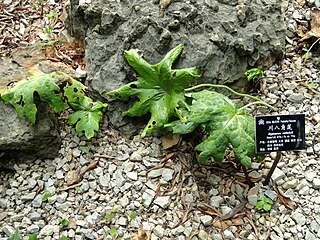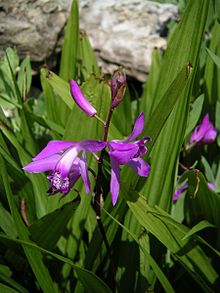
Pleione is a small genus of predominantly terrestrial but sometimes epiphytic or lithophytic, miniature orchids. This genus is named after Pleione, mother of the Pleiades, and comprises about 20 species. Common names of this genus include peacock orchid, glory of the east, Himalayan crocus, Indian crocus and windowsill orchid. The genus DiploconchiumSchauer is generally included here. Pleione is abbreviated to Pln in trade journals.

Indocalamus is a genus of about 35 species of flowering plants in the grass family (Poaceae), native to China, Vietnam and Japan. They are quite small evergreen bamboos normally up to 2 m (6.6 ft) in height, initially forming clumps and then spreading to form larger thickets. They have thick, glossy leaves. Ruo leaves use to wrap foods like rice during dragon boat festival, originate in fujian refer to Indocalamus longiauritusoriginally but now are nonspecific to just about any leaf wrap.

Adenophora is a genus of flowering plants in the family Campanulaceae, the bellflowers. Plants of this genus are known commonly as ladybells. Most of the species in the genus are native to eastern Asia, with a few in Europe. Many are endemic to either China or Siberia.

Osmanthus is a genus of about 30 species of flowering plants in the family Oleaceae. Most of the species are native to eastern Asia with a few species from the Caucasus, New Caledonia, and Sumatra. Osmanthus has been known in China since ancient times with the earliest writings coming from the Warring States period; the book Sea and Mountain. South Mountain states: "Zhaoyao Mountain had a lot of Osmanthus".

Maianthemum includes the former genus Smilacina and is a genus of perennial herbaceous flowering plants with fleshy, persistent rhizomes. It is widespread across much of North America, Europe and Asia, and may be terrestrial, aquatic or epiphytic. It is characterized by simple, unbranched stems that are upright, leaning or hanging down and have 2–17 foliage leaves. Leaves are simple and may clasp the stem or be short-petiolate. The inflorescence is terminal and either a panicle or a raceme with few to many pedicelate flowers. Most species have 6 tepals and 6 stamens; a few have parts in 4s. Tepals are distinct in most species and all of similar size. Flowers are spreading, cup-shaped or bell-shaped and usually white, but lavender to red or green in some species. Fruits are rounded to lobed berries containing few to several seeds.

Paris is a genus of flowering plants described by Linnaeus in 1753. It is widespread across Europe and Asia, with a center of diversity in China.

Ophiopogon (lilyturf) is a genus of evergreen perennial plants native to warm temperate to tropical East, Southeast, and South Asia. Despite their grasslike appearance, they are not closely related to the true grasses, the Poaceae. The name of the genus is derived from Greek ὄφις ophis, 'snake' and πώγων pogon, 'beard', most probably referring to its leaves and tufted growth. In the APG III classification system, it is placed in the family Asparagaceae, subfamily Nolinoideae. Like many lilioid monocots, it was formerly classified in the Liliaceae.

Aletris, the colicroot, colicweed, crow corn, or unicorn root, is a genus of flowering plants in the family Nartheciaceae, native to North America and to eastern and southeastern Asia, especially China. It was used as a component in Lydia Pinkham's original Vegetable Compound.

The genus Helwingia consists of shrubs or rarely small trees native to eastern Asia, the Himalayas, and northern Indochina. It is the only genus in the family Helwingiaceae.

Neottia is a genus of orchids. The genus now includes the former genus Listera, commonly known as twayblades referring to the single pair of opposite leaves at the base of the flowering stem. The genus is native to temperate, subarctic and arctic regions across most of Europe, northern Asia, and North America, with a few species extending into subtropical regions in the Mediterranean, Indochina, the southeastern United States, etc.

Iris confusa (; also known as the bamboo iris is a species of iris. It is also in the subgenus Limniris and in the section Lophiris. It is a rhizomatous perennial plant, native to Western China. It has flowers which range from white to a soft lavender or pale blue in colour, with orange-yellow crests and purple dots. The plant's broad, shiny leaves are attached to bamboo-like stems. It is cultivated as an ornamental plant in temperate regions.

Pholidota, commonly known as rattlesnake orchids, is a genus of flowering plants from the orchid family, Orchidaceae. Plants in this genus are clump-forming epiphytes or lithophytes with pseudobulbs, each with a single large leaf and a large number of small, whitish flowers arranged in two ranks along a thin, wiry flowering stem that emerges from the top of the pseudobulb. There are about thirty five species native to areas from tropical and subtropical Asia to the southwestern Pacific.

Bletilla ochracea, commonly known as Chinese butterfly orchid, is a species of orchid native to Vietnam and China.

Bletilla striata, known as hyacinth orchid or Chinese ground orchid, is a species of flowering plant in the orchid family Orchidaceae, native to Japan, Korea, Myanmar (Burma), and China. It is most commonly found growing in clumps alongside grassy slopes with sandy soil.

Cypripedium tibeticum is a species of slipper orchid in the section Cypripedium in the subsec. Macrantha It is native to Bhutan, Sikkim, and Western China.

Oreorchis is a genus of flowering plants from the orchid family, Orchidaceae. It is native to Asia. Species currently accepted as of June 2014:
- Oreorchis angustataL.O.Williams ex N.Pearce & P.J.Cribb - Sichuan, Yunnan
- Oreorchis aurantiacaP.J.Cribb & N.Pearce - Myanmar
- Oreorchis bilamellataFukuy. - Taiwan
- Oreorchis discigeraW.W.Sm. - Myanmar
- Oreorchis erythrochryseaHand.-Mazz. - Tibet, Sichuan, Yunnan
- Oreorchis fargesiiFinet - Fujian, Gansu, Hubei, Hunan, Shaanxi, Sichuan, Taiwan, Yunnan, Zhejiang
- Oreorchis foliosa(Lindl.) Lindl. - India, Assam, Nepal, Bhutan, Myanmar, Tibet, Sichuan, Taiwan, Yunnan
- Oreorchis itoana(F.Maek.) Perner - Honshu
- Oreorchis micranthaLindl. - Tibet, Taiwan, Assam, India, Bhutan, Nepal, Myanmar
- Oreorchis nanaSchltr. - Sichuan, Yunnan, Hubei
- Oreorchis nepalensisN.Pearce & P.J.Cribb - Nepal, Tibet
- Oreorchis oliganthaSchltr. - Gansu, Sichuan, Tibet, Yunnan
- Oreorchis parvulaSchltr. - Sichuan, Yunnan
- Oreorchis patens(Lindl.) Lindl. - Japan, Korea, Russian Far East, China
- Oreorchis porphyranthesTuyama - Nepal
- Oreorchis sanguinea(N.Pearce & P.J.Cribb) N.Pearce & P.J.Cribb - Bhutan

Cardiocrinum giganteum, the giant Himalayan lily, is the largest species of any of the lily plants, growing up to 3.5 metres high. It is found in the Himalayas, China and Myanmar (Burma).

Dysosma is a group of herbaceous perennials in the Berberidaceae or barberry family described as a genus in 1928. It is native to China and Indochina.

Isodon (teacost) is a genus of flowering plants in the family Lamiaceae described in 1840. It is native to tropical and subtropical parts of the Old World, primarily Asia but two species are from Africa. Many of the species are endemic to China, where it is called xiangchacai or "fragrant tea".

Rhomboda, commonly known as velvet jewel orchids, is a genus of about twenty species of flowering plants in the orchid family Orchidaceae. Plants in this genus are mostly terrestrial herbs with a fleshy, creeping rhizome and a loose rosette of green to maroon coloured leaves. Small resupinate or partly resupinate, dull coloured flowers are borne on a hairy flowering stem. The dorsal sepal and petals overlap and form a hood over the column and there is a deep pouch at the base of the labellum. They are found in tropical regions from northern India through Southeast Asia, China, Japan to Australia and some Pacific Islands.
























